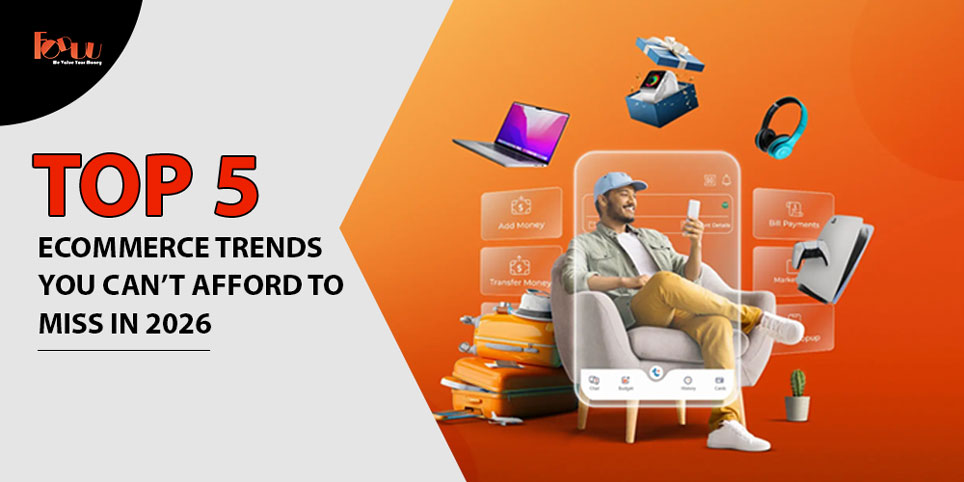The ecommerce business has never moved faster than it does today, driven by rapid technological innovation, changing consumer expectations, and an increasingly competitive marketplace. Going into 2026, brands cannot rely on traditional ways of selling online. Modern buyers require speed, personalization, efficiency, and immersive experiences delivered seamlessly across a wide array of digital touchpoints.
Whether you're an established ecommerce brand, a fast-growing AI-based ecommerce web development startup, or a retailer who's ready to scale, staying ahead of these trends is not optional-it's a matter of survival.
Following are the top five ecommerce trends that will dominate 2026 and how you can use them to future-proof your business strategy.
1. AI-driven hyper-personalization will leave its mark on every customer journey
Personalization is not just a matter of showing "recommended for you" product sections to customers anymore. In 2026, ecommerce personalization, driven by ongoing improvements in AI, machine learning, and predictive analytics, will be deeply intelligent and hyper-specific.
What Hyper-Personalization Looks Like in 2026
Real-time product recommendations based on browsing behavior, purchase intent, and microsegments.
-
Users can customize their homepage layout.
-
AI-driven dynamic pricing models.
-
Personalized offers and discounts based on one's lifetime value.
-
Shopping experiences driven by emotion and behavioral analysis.
AI can understand not just what the customer wants but also why they want it. Companies are now using advanced customer data to create 1:1 shopping journeys that feel intuitive and highly relevant.
Why This Trend Matters
With today's consumers, there are a lot of choices, and they need recommendations for decision-making both with speed and accuracy. If your ecommerce platform cannot predict what they want next, another one will.
How Brands Can Adapt
-
Invest in an AI recommendation engine.
-
Integrate behavioral analytics tools.
-
Create customer profiles using first-party data.
-
Automate emails, SMS, and push notifications that contain dynamic content.
Conversions rise with hyper-personalization, and repeat purchases go up, whereas customer satisfaction increases massively, which is why this is one of the most influential trends of 2026.
2. AR & VR Shopping Will Replace Traditional Online Browsing
By 2026, consumers will want more than flat product photography and basic descriptions; the desire will be to be immersed in an interactive, experiential shopping experience-something closer to real-world retail.
The result is that this has propelled AR and VR right to the forefront of innovations in e-commerce.
Examples of AR/VR in 2026 E-commerce
-
Virtual try-ons of clothes, accessories, shoes, and beauty products.
-
3D furniture placement inside rooms.
-
VR stores that customers can walk through, using headsets.
-
Instant AR overlays with product comparisons.
-
Interactive product demonstrations can be rotated, zoomed, and tested digitally by customers.
-
Shopping is increasingly becoming an experience, not just a transaction.
Why Consumers Love AR & VR
-
High certainty before buying
-
Reduced returns
-
Improved understanding of the quality and fit of products
-
A sense of engagement and interactivity
With AR so readily available on smartphones and VR becoming increasingly mainstream, customers are expecting these advanced shopping features from brands.
How Brands Can Adapt
-
Develop AR modules for best-selling product categories.
-
Add 360-degree product viewing experiences.
-
Explore partnerships with AR/VR technology providers.
-
Create virtual showrooms of premium collections.
By 2026, only immersive shopping experiences offered by brands will be ahead of the pack, while other browser-based experiences will fall behind.
3. Unified Commerce Beyond Omnichannel Becomes the New Norm
For years, omnichannel retail had been the gold standard. But in 2026, unified commerce has taken over-and it's more than just connecting a variety of channels: It is about integrating all customer touchpoints into one single harmonized system.
Unified Commerce vs. Omnichannel
-
Omnichannel: The channels are connected, but each one still functions separately.
-
Unified Commerce: Omnichannel is executed on one platform, creating a seamless experience for the customer.
What Unified Commerce Looks Like
-
Inventory synced in real time across stores, warehouses, and online.
-
Single customer database for retail, app, website, and social commerce.
-
consistent pricing, offers, and loyalty benefits across all touchpoints
-
Immediate tracking of your order, regardless of where you have purchased it.
-
Easy returns at any location, online or offline.
Why This Trend Matters
-
The customers expect flexibility. They want:
-
Browse online, buy in store
-
Check inventory in store via mobile.
-
Buy online, pick up in store
-
Buy from social media and return on the website.
Not only does unified commerce meet these expectations, but it also provides the business with a clear view of customer behavior across the whole ecosystem.
How Brands Can Adapt
-
Establish a centralized commerce management system.
-
Adopt cloud-based POS and inventory tools.
-
Unify loyalty programs together with user profiles.
-
Automate processes involved in supply chain operations.
Moving forward, in 2026, unified commerce will be indispensable for any brand that wants to give customers an integrated, frictionless, and memorable shopping experience.
4. Sustainable Ecommerce Will Shift from Trend to Expectation
Sustainability has been on the rise for years, but coming into 2026, it's no longer a marketing plus; it's an expectation. Conscious consumerism is drastically changing the way people buy across various industries.
What Consumers Will Expect in 2026
-
Eco-friendly packaging
-
Carbon-neutral delivery options
-
Transparent sourcing and manufacturing
-
Ethical labor practices
-
More durable products, longer shelf life.
-
Recycling and return-to-recycle programs
Today, brands are held responsible by customers not only for the final product, but throughout the whole product life cycle.
Why Sustainability is Important
-
Members of Gen Z and Gen Alpha are the most eco-conscious young consumers.
-
Regulations associated with sustainable packaging and waste reduction continue to tighten.
-
Eco-friendly practices build brand trust and loyalty.
How Brands Can Adapt
-
Switch to biodegradable or recycled packaging.
-
Employ environmentally friendly delivery and routing systems.
-
Emphasize commitment to sustainability on product pages.
-
Introduce repair services that reduce product waste.
-
Increasing energy efficiency in warehousing and shipping.
Those who take sustainability seriously have more loyal customers and higher brand value, a trend that should not be missed this year, 2026.
5. Voice Commerce & Conversational AI will be a huge revenue channel
With the exponential rise in voice assistants and conversational AI tools, consumer shopping will be revolutionized by them in 2026. While smart speakers, voice-enabled devices, and AI chatbots have become part of one's daily life, significant portions of e-commerce interactions are happening via voice and conversational interfaces.
Voice Commerce in Action
-
Customers placing verbal orders for groceries, provisions, or repeats.
-
Voice search powering product discovery.
-
Conversational bots offering personalized shopping guidance.
-
AI assistants track orders, respond to queries, and handle returns.
With AI getting more natural, contextual, and emotionally intelligent, conversational commerce has become smooth and intuitive.
Why This Trend Matters
-
Voice search is quicker and easier than typing.
-
Consumers like frictionless interactions.
-
They reduce operational costs, hence increasing conversions.
-
Voice Commerce enables multitasking and, therefore, eases daily purchases.
How Brands Can Adapt
-
Optimize product listings for voice search queries.
-
Add conversational AI chat support to websites and apps.
-
Offer voice-enabled shopping for repeat orders.
-
Upsell, cross-sell, and re-engage customers using AI assistants.
Though voice commerce may still be in its infancy, this channel will be one of the mainstream revenue channels through 2026, specifically for quick and everyday purchases.
Final Thoughts
In 2026, ecommerce is smarter, quicker, and more immersive. The brands which would thrive are those who understand a shifting digital landscape and could move with speed. From hyper-personalized experiences to sustainable practices, the unified commerce ecosystem, and AI-driven interactions, the future belongs to companies that innovate boldly.
Keeping pace with the top five trends isn't just staying relevant; it's about staying ahead. If you want your ecommerce brand to stand out in 2026 and beyond, now is the best time to get started with these strategies and redefine customer experiences at every touchpoint by getting in touch with experienced e-commerce website design & development company like FODUU where everyone will be available all the time to assist you in the best possible way.



